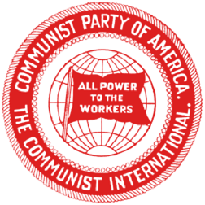
PARTY HISTORY
(I)—The Communist Labor Party of America
During 1919, the Left Wing Section of the Socialist Party of America carried on an active campaign to win a majority of the SPA's governing National Executive Committee. It ran slates of candidates in each of the six electoral districts and sought those branches and locals committed to its program to vote solidly for its slate. National Executive Secretary Adolph Germer and the outgoing NEC cried foul against bloc voting by Left Wing branches and made the claim that the Left Wing Section was a “Party Within the Party.” A series of suspensions and expulsions followed. The outgoing NEC invalidated the results of the 1919 SPA election and set about electing a slate of delegates to the forthcoming National Emergency Convention in Chicago who were loyal to it. The Left Wing Section split in half over how to respond to these gross violations of party legality by the outgoing NEC. One faction, dominated by the suspended Language Federations of the SPA, sought the immediate formation of a Communist Party in America. This group became the (old) Communist Party of America. Another group, headed by the “invalidated” National Executive Secretary-elect Alfred Wagenknecht and a number of prominent Left Wing SP members, sought to win over the National Emergency Convention—and, only upon failing at that, to take as many “firendly” delegates as possible away from that gathering into a new Communist organization. This group tried and failed to win over the (stacked) National Emergency Convention of the SPA and duly consituted themselves the Communist Labor Party of America (CLP). Here, a Statement of the Illinois Delegates Who Withdrew from the Emergency Convention and Participated in the Formation of the Communist Labor Party. [September 1919]. From an October issue of The Proletarian comes this perspecitve on the Michigan Convention
1. —“Founding Convention”—Chicago, IL—Aug. 31 - Sept. 5, 1919
The Founding Convention of the CLP named Alfred Wagenknecht as National Executive Secretary, a position which he held for the entire 8 months that the organization existed. The CLP campaigned ceaselessly for unity between the two Communist Parties—on the basis of party equality, a system which would give the members of the CLP representation in excess of their actual organizational size. The CLP's entreaties were repeatedly rebuffed by decision-makers in the old CPA.
Items of possible interest available here include downloadable Minutes of the Left Wing Caucus to the 1919 Convention of the SPA, Minutes of the Founding Convention of the CLP, and a web page listing delegates to the convention.
The CLP established its initial headquarters in Cleveland, Ohio. It initially had a state-based system of organization similar to that of the Socialist Party, making use of “State Secretaries” [List of State Secretaries and Representatives, as of November 1919] and being organized along territorial lines in county or city “locals”—the largest of these subdivided into “branches.” This system of organization was changed when the party was driven underground by the Palmer Raids of January 1920.
The CLP applied for Comintern membership with a letter to Moscow by Wagenknecht dated Sept. 21, 1919.
Second Plenum of the NEC—New York, NY—Oct. 25-27, 1919.
The second plenum of the National Executive Committee of the CLP was held in New York City from Oct. 25-27, 1919. The sessions were attended by the entire NEC: National Secretary Alfred Wagenknecht and NEC committeemen Max Bedacht (San Francisco), Alexander Bilan (Cleveland), L.E. Katterfeld (Cleveland), Jack Carney (Duluth), and Edward Lindgren (Brooklyn). The group heard an organizational report by Wagenknecht, in which he stated that a total of 6,788 charter (initiation) stamps had been ordered to date, plus 14,976 monthly dues stamps and 657 dual husband/wife monthly dues stamps. State organizations wer chartered in 9 states, with several others due to follow in short order and additional unorganized states to be divided into regional districts. The group addressed the ongoing unity discussions with the Communist Party of America and established an editorial board and an array of publications, including a new bi-weekly official newspaper to replace Communist Labor Party News called Communist Labor. Max Bedacht was named editor of this publication. The NEC voted to absorb the backstock of publications of the Socialist Publishing Society, including the theoretical magazine The Class Struggle, and to issue this magazine and other future publications in its own name. Ludwig Lore was named editor of The Class Struggle and Jack Carney and A. Raphailoff were elected associate editors. The session also voted to move party headquarters from Cleveland to New York, effective in November 1919.
(II) —The (old) Communist Party of America (CPA)
The members of the Left Wing Section of the CPA who had given up on “winning” the Socialist Party altogether prepared a founding convention for a new Communist Party to be held in Chicago at the same time as the Socialist Party's gathering.
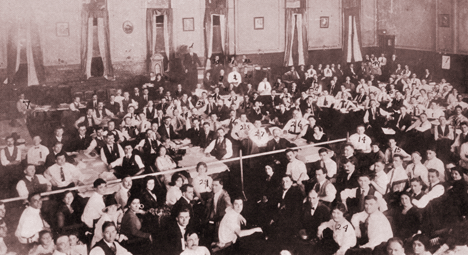
1. —“Founding Convention”—Chicago, IL—Sept. 1 - 7, 1919
The Founding Convention of the old CPA was attended by approximately 125 delegates. The group was divided into three caucuses, the Russian Federation group (about including Latvian, Lithuanian, Polish, Ukrainian, and Jewish Federation members and headed by Alexander Stoklitsky, D. Elbaum, George Ashkenudzie, Nicholas Hourwich); the National Left Wing Council group (about 30 adherente including prominently Charles Ruthenberg, Isaac Ferguson, Louis Fraina, John Ballam, and Maximilian Cohen); and the Michigan group (about 20 adherents including Dennis Batt and John Keracher).
The Convention drafted and approved a Constitution and Program and established an organizational framework in which the convention elected a Central Executive Committee of 15, as well as an Executive Secretary and Editor. Five members of the CEC living in the headquarters city of the organization (New York) plus the Executive Secretary and Editor were to constitute themselves as the Executive Council, the day-to-day governing body of the group.
A stenographic report seems to have been kept of the meeting; it was never published and to date a copy of this document has never surfaced.
At 9 pm on the evening of Nov. 8, 1919, simultaneous search warrants were executed on 71 “headquarters” of the Communist Party of America scattered around New York city. The coordinated raid was conducted by the New York Joint Legislative Committee Investigating Seditious Activities (the “Lusk Committee") under the direction of Inspector Joseph Faruot of the New York Police Department, leading over 700 members of the NYPD. Tons of literature were seized and “a large number” of prisoners taken. Among those arrested on that date were Benjamin Gitlow and James Larkin, co-editors of The Revolutionary Age.
(fn. Stevenson (ed), Lusk Committee Report, v. 1, pp. 22-23.)
2. —“Second Convention”—New York City—July 13 - 18, 1920
The Second Convention of the CPA was held in conditions of extreme secrecy due to harsh repression of the radical movement that was then taking place across the country. A complex system of direct elections was used, outlined in the convention call, in which groups elected delegates to a sub-district meeting, the sub-district meetings elected delegates to District Conventions, and the District Conventions elected the delegates to the actual National Convention. A total of 24 delegates and 5 members of the Central Executive Committee attended the gathering, which was held in New York City.
The report of the Central Executive Committee was delivered by the party's Acting Secretary, Charles Dirba ["D. Bunte"]. The Convention was chaired by Louis Schapiro ["Lawrence Bain"], who was elected to the Central Executive Committee of the party by the convention and subsequently selected as Executive Secretary of the organization at a meeting of the CEC held July 20, 1920.
CEC Plenum —New York City --- Jan. 11-16, 1921
3. —“Extraordinary Third Convention”—Brooklyn, NY —Feb. XX - XX, 1921
The Extraordinary Third Convention was in conditions of extreme secrecy as a by-product of the Comintern's instruction that all member parties hold conventions to ratify the decisions of its 2nd Congress. As was the case with the CPA' s 2nd Convention, this convention was composed of delegates elected via a complicated system of elections beginning at the branch level, which elected to a local convention, local conventions electing to a sub-district convention, subdistrics electing to a district convention, and the district conventions finally selecting delegates. The process began in December 1920 on a date not specified in the original convention call document.
The gathering lasted 10 days and was attended by 30 delegates and 7 fraternal delegates, who discussed and ratified the theses of the Communist International. The convention also discussed parliamentarism, the structure of the party in the shops, the role of the party in the unions, the role of the federations, and reaffirmed that future unity with the United Communist Party was to take place only on the basis of proportional representation—a system which would assure that decisive authority would be vested in the hands of the former members of the (old) CPA.
The Extraordinary Third Convention adopted a Program and Constitution for the CPA.
[fn. Date and location here are from Highlights From a Fighting History, pg. 491.]
Dues in the Communist Party of America were 60 cents per month. The Language Federations collected dues and remitted a portion of collected funds to the center, retaining 20 cents per member per month to cover their costs of operation.
(III) —The United Communist Party of America (UCP)
On April 18, 1920, C.E. Ruthenberg resigned as National Executive Secretary of the (old) Communist Party of America and, together with Jay Lovestone, I.E. Ferguson, and a circle of largely anglophonic supporters, departed to constitute themselves as an independent group in preparation for unity with the Communist Labor Party. This “Minority Group” took with them the bulk of the CPA's funds and went so far as to publish their own version of the party's organ, “The Communist,” using the same volume and issue numbers as the CEC Majority Group.
On May 25, 1920, delegates of both the Ruthenberg Minority Group of the CPA and the Communist Labor Party arrived at Bridgman, Michigan, and conducted their own preparatory caucus meetings. The CPA pre-convention was attended by 32 delegates, representing 6,119 members, and the CLP pre-convention by 25 delegates, representing 4,525 members.
1. —“Joint Unity Convention”—Bridgman, MI—May 26 - 31, 1920
[Note: The CPUSA's Highlights of a Fighting History erroneously states that this convention started May 15, 1920.]>
The next day, May 26, these two “mini-conventions” joined into one large body, a “Unity Convention,” where it constituted itself as the United Communist Party of America (UCP). There were 32 CPA delegates, 25 CLP delegates, and one fraternal delegate who caucused with the CLP. The Belorussian Communist Samuel Agursky presented a credential of the ECCI with a mandate to asist in the formation of a united party.
There are three accounts of the 1920 Bridgman convention that have come to light, all from the perspective of the CPA. The first is a lengthy account of the seven days of the convention, written by Isaac Ferguson, which was published in the official organ of the United Communist Party. A shorter and less important account was also published by C.E. Ruthenberg in that same issue. A third, rather dissident, account was published in the Yiddish language edition of The Communist by “R.Newman” and recounts the Convention from the perspective of the CPA's informal “Left” faction at that gathering. The “Newman” account was actually translated and published by the Majority CPA as a factional document in an effort to undercut the version of “unity achieved” put forward by Ferguson and Ruthenberg. A lengthy and hostile critique of the Ferguson and Ruthenberg accounts was also published by the editor of the CPA's official organ, Maximilian Cohen.
The delegates of the Ruthenberg-CPA were animated against the continuation of language federations, while the institution of the federations had support from a segment of the membership of the old Communist Labor Party. After debate the institution of language federations was eliminated from the structure of the new organizations.
The convention approved a consitution for the UCP and spent a great deal of effort debating and approving a program for the organization. It also passed a number of resolutions. After much drama and tension spread out over two days, the group also elected ten members of the Central Executive Committee—five from each party. The original conception was for a 9 member CEC, but chaos ensued when five members of the former CLP were elected—a working majority —which prompted the resignation of C.E. Ruthenberg and two of his allies from the newly-elected body and a restructuring of the CEC.
The new CEC met immediately after the convention and elected Alfred Wagenknecht as Executive Secretary of the UCP. C.E. Ruthenberg was elected Editor of The Communist, the official organ of the party. The party also established a network of 11 regional districts for the organization. An account of this CEC meeting, including specific locations of each district, was published in the party press.
2. —“Extraordinary Second Convention”—Kingston, NY —Dec 24 - XX, 1920
The Second Convention of the UCP was called to ratify the decisions of the Second Congress of the Communist International in Moscow. Dates of the secret gathering are still not clear, although UCP CEC minutes in November specified a date of “not later than Dec. 24” and the line in the 1921 Q-I budget calls the meeting “Convention (xmas)."
In addition to ratifying the actions of the 2nd Congress of the Comintern and adopting a new program for the organization, the 2nd Convention of the UCP notably committed itself to move forward with the organization of a Youth Section for the UCP, to be known as the “Young Communist League of America, Section of the Young Communist International."
Dues in the UCP were 75 cents per month, collected by group captains and remitted to District Organizers.
(IV) —The Communist Party of America, Section of the Communist International
(a.k.a. “unified CPA")
Faced with loss of recognition by the Communist International in Moscow if they could not find a way to bury the hatchet and unite, the UCP and the (old) CPA found themselves forced into a marriage, which finally took place in May of 1921. It was this gathering that should be regarded as the founding convention of the American Communist Party, akin to the 1901 Unity Convention held in Indianapolis that is heralded as the moment of birth of the Socialist Party of America.
1. —“Unity Convention”—Woodstock, NY—May 15 - 28, 1921
The Joint Unity Convention was attended by 60 delegates, 30 each from the United Communist Party and the (old) Communist Party of America. The report of the CEC of the United Communist Party was delivered by Executive Secretary Alfred Wagenknecht ["Paul Hole"], who related the UCP's organizational history and emphasized the group's commitment to unity and willingness to submit to the solutions proposed by the Comintern. The report of the CEC of the old Communist Party of America was delivered by Charles Dirba ["C. Dobin"], who defended the group's Federations structure emphasized his group's commitment to building an effecttive revolutionary organization and a commitment to propagate the idea of the inevitability armed insurrection amongst the workers. Both of these lengthy reports illustrate well the history and differing concerns of each of these underground organizations.
The delegates haggled over details of merger, a constitution, and a program for two weeks before finally coming “to a unanimous agreement on every essential point.” There was a great deal of unanimity on programmatic issues, but negotiations over the constitution to establish the form of the organization were met with a series of party-line votes. Eventually, a negotiations committee consisting of five members from each side, worked out a compromise, the formation of a Central Executive Committee containing five members from each party—to which were deferred the bitterly divisive matters of the district structure and paid party organizers.
[fn. Official Bulletin of the Communist Party of America (Section of the Communist International), no. 1 [May 1921], pg. 1]
(V) —Central Caucus faction's “Communist Party of America” / United Toilers Party
The Central Caucus faction broke from the CPA as an alternative party at the end of November and in the first part of December 1921. This split was largely caused by the decision to move forward with a “Legal Political Party”—the Workers' Party of America—which would operate without pseudonyms or clandestine organizational forms, thus jeopardizing the entire movement, it was believed. To a large extent, the Central Caucus Faction marked a return of the old-CPA to organizational independence. It was a minority group, however, as only a portion of the old-CPA broke with the unified-CPA at this time.
This group used various names during its brief tenure, initially calling itself the “Central Caucus,” before (confusingly) using the name “Communist Party of America, Section of the Communist International” in parallel with the “regular” organization. The party also had a half-hearted shell of an associated Legal Political Party called the “United Toilers Party."
The Central Caucus faction was headed by three former members of the Central Executive Committee of the unified CPA: Charles Dirba, George Ashkenudzie, and John T. Ballam.
1. —“Emergency Convention of the CPA”—(city?)— Jan. 7 - 12, 1922
The “Emergency Convention of the Communist Party of America” was the first conclave of the Central Caucus Faction. It was attended by 20 delegates as well as 18 fraternal delegates representing the Central Executive Committee, the languarge federations, the Young Communist League, and even three delegates of the Proletarian Party. The gathering heard reports of a total membership of approximately 4400, with 95% of this number concentrated in the Lithuanian (1100), Ukrainian (1000), Russian (900), Latvian (630), Polish (400), and Jewish (150) Federations. Half of the organization was concentrated in the Boston, New York, and Philadelphia districts.
The Convention heard a report on a plan for legal organization and rejected a proposition to recognize the Proletarian Party as “the legal expression of the Party.” A raft of constitutional amendments were adopted and a resolution on the Young Communist League passed instructing the CEC to put all efforts in developing a unified YCL, not split along factional lines, but built instead on the principle of “organizational neutrality."
Robert Minor addressed the gathering on behalf of the CPA majority group, reading communications from the Executive Committee of the Comintern on Legal Activities and the Legal Political Party.
Elections were held to choose a 7 member Central Executive Committee, and John Ballam was elected as “Special International Delegate” to state the group's case in Moscow before the Comintern. The gathering approved a Constitution of the organization and the events of the convention were reported to the membership in the underground press.
[fn. “Condensed Minutes of CPA Emergency Convention, Jan. 7-11, 1922. Copy in Comintern Archive f. 515, op. 1, d. 130, ll. 1-2.]
The Comintern in Moscow was adament and unwavering against this split, however. Ballam was sent to Moscow by the organization to argue his case. He received a chilly greeting and an instruction in no uncertain terms that the Central Caucus faction should terminate its split and return to the majority group's Communist Party of America. Ballam agreed to do just that and returned to the United States on May 7, 1922. The next day a conference was held including the top leadership of the Central Caucus faction: it's officials, 7 district organizers, heads of the Jewish, Ukrainian, Russian, Latvian, Polish, and Lithuanian Federations, and the editor of its official English Language press.
2. —“Conference”—New York City—May 8 - 12, 1922
The participants at this Conference refused to comply with the instructions of the Executive Committee of the Comintern, relayed by Ballam, instead wishing to continue their organizational independence in hopes of appealling over the heads of the ECCI to the next Congress of the Communist International.
Ballam broke with the Central Caucus faction over this failure to comply with the instructions of the ECCI to reunify with the CPA majority and went on a tour around the country attempting to appeal to the rank-and-file of the Central Caucus faction to rejoin the CPA majority in spite of the refusal of their leaders.
(VI) —The Workers Party of America (WPA)
Left Sectarianism was one of the big problems in the world communist movement, according to Lenin, Zinoviev, and other principle figures in the Comintern. This was used by those favoring an open, mass Communist Party in America as a pretext for formation of a parallel “legal” organization, the Workers Party of America (WPA). The decisive majority of the Founding Convention came from the ranks of the CPA; delegate nominations for this gathering came from the various District Organizers and which were approved by the Central Executive Committee. The Founding Convention of the WPA was organized and conducted in conditions of semi-secrecy.
1. —“Founding Convention”—New York City—Dec. 23 - 26, 1921
The Workers Party of America was born as the result of a convention call issued over the signature of the American Labor Alliance for Trade Relations with Soviet Russia and its affiliated foreign language federations, the Workers' Council group which had recently left the Socialist Party of America, the Jewish Socialist Federation, and the Workers Educational Association. In reality, the motive force behind the organizaiton was the underground Communist Party of America, which carefully mooted the gathering's delegates. In all, 164 delegates and some 100 fraternal delegates attended the founding of the WPA. While there was no convention of the underground CPA prior to the convocation of the founding convention of the WPA, as sought by the Comintern, the CPA delegates to the gathering did hold a 3 day caucus prior to the WPA event, at which programmatic documents were agreed upon. This served the same practical effect.
The gathering approved a Constitution and Program for the new organization.
Max Eastman attended the convention on behalf of his magazine, The Liberator, and he turned in an enthusiastic report of the event.
(IV again)—The Communist Party of America, Section of the Communist International
(a.k.a. “unified CPA")
2. —“2nd National Convention”—Bridgman, MI—Aug. 17 - 22, 1922
The Bridgeman Convention of 1922 was an absolute debacle, held in secret in a state with a strict “Criminal Syndicalist” Law. The gathering was penetrated by an agent of the Department of Justice, Francis Morrow (party names “Day” and “Ashworth"), who was elected as a delegate from Camden, NJ—the raid resulting in a series of litigation that tied up the energy and resources of the American Communist movement for years.
The Bridgman Convention was held in gullies amidst wooded dunes on the estate of Karl Wolfskeel, less than a mile from Bridgman and about 12 miles from the neighboring towns of St. Joseph and Benton Harbor. The “Wolfskeel Summer Resort” had a number of cottages that were routinely rented out to campers, which served to house the 70 or so who attended the gathering. The location could be reached only by an unpaved road, which helped to maintain the site's isolation. The meeting was attended by “Ward Brooks” (aka Genrikh Valetskii, born Maximilian Horwitz) as the representative of the Communist International.
[fn. R.M. Whitney, Reds in America. (NY: Beckwith Press, 1924), pp. 20-21.]
The Bridgman Convention was called to order by Executive Secretary Jay Lovestone on behalf of the party's Central Executive Committee. The agenda of the gathering was crowded with discussions on a wide range of topics. Ben Gitlow and Caleb Harrison were chosen as chairmen of the convention, heading its various sessions and resolving matters of parliamentary procedure. Comintern Rep Valetskii delivered a keynote address to the gathering in German, during which hestated that while capitalism's economic prospects were improving, the consciousness of the workers was still growing and the class struggle sharpening. The Communist Party had emerged from its factional struggles stronger than before, having carefully studied various questions of tactics, Valetskii hopefully asserted.
Jay Lovestone reported on the progress of the party-related organizations the African Blood Brotherhood and The World War Veterans, while on Saturday, Aug. 19, William Z. Foster addressed the gathering on behalf of the Trade Union Educational League.
The agenda of the gathering was chiefly concerned with the issue of whether the underground CPA should be dissolved and was divided on the issue between a narrow majority favoring retention of the underground organization (the “Goose Caucus") and a slight minority favoring its termination (the “Liquidators").
Abram Jakira ["J. Miller"] was named Executive Secretary of the underground CPA by the convention.
Aware that there was a growing police presence in the little town of Bridgman, the convention was prematurely terminated (with no final decision reached on the status of the underground party) and its documents buried in two barrels. Early in the morning of Tuesday, Aug. 22, the gathering was sensationally raided by police, with the hidden cache of documents easily uncovered due to Morrow's penetration of the gathering. Some 17 members of the CPA were arrested on the site, with many other participants—including Foster— arrested later under warrants issued on the basis of documents seized in the Bridgman raid.
The following members of the CPA were arrested in conjunction with the Bridgman convention: Phillip Aronberg, Alex Bail, Eugene Bechtold, Earl R. Browder, William F. Dunne, Charles Erickson, William Z. Foster, Alex Georgian, Caleb Harrison, Charles Krumbein, Cyril Lambkin, Max Lerner, Elmer McMillin, John Mihelic, Seth Nordlind, Thomas J. O'Flaherty, William Reynolds, C.E. Ruthenberg, A. Severino, T.R. Sullivan, Norman H. Tallentire, and Joseph Zack [Kornfeder].
A legal defense organization called the “Labor Defense Council” emerged in the fall of 1922 to raise consciousness about the fate of the Bridgman defendants and funds for their trials. This group, of which William Z. Foster was National Secretary, included a 21-member National Committee, including such non-CPA figures as Roger N. Baldwin of the ACLU, Father John A. Ryan of the Catholic Welfare Council, Eugene V. Debs of the Socialist Party, and John Haynes Holmes.
3. —“3rd National Convention”—New York City—April 7, 1923
The April 1923 Convention was the final gathering of the “underground” CPA. All caucuses and factionalism was expressly banned at the gathering by the Jan. 26, 1923, decision of the Central Executive Committee. A convention call issued in February outlined the procedure for election of delegates and made clear the very limited agenda with its rather definite perscription.
The meeting was attended by 19 regular delegates (Boston - 3; New York - 5; Philadelphia - 1; Cleveland - 2; Chicago - 3; Detroit - 2; St. Louis - 1; Pittsburgh - 1; Minneapolis - 1). In addition there was 1 delegate from the Young Communist League and 13 members and 2 alternates of the Central Executive Committe, for a total of 35 in all.
The official view of the Central Executive Committee calling for the liquidation of the underground CPA was delivered by three: A John Pepper {"Sh---” = “Short"] delivered the main report, with C.E. Ruthenberg ["Br---” = “Brenton"] making the presentation for the second agenda item, “The Question of the Open Party.” Ruthenberg was the Executive Secretary of the CPA's legal arm, the Workers Party of America—an organization which was significantly larger and substantially more vital than its erstwhile parent by 1923.
The body unanimously approved a thesis prepared by the Central Executive Committee which liquidated the underground CPA organization. An apparatus within the legal party designed for secret operations to safeguard the organization and carry on confidential work was also established, with Abraham Jakira named the “Secretary for Confidential Work.” This apparatus for confidential work was the subject of a small bit of controversy at the Convention, as Ludwig Katterfeld argued that the group should consist of the whole of the former underground CPA and that its further membership be elective; instead the conception of a much smaller group of trusted party members appointed to the tasks as needed was unanimously approved.
Letters to the Communist International and to the Workers Party of America written Wednesday, April 11, 1923, in the name of the CPA by Executive Secretary C.E. Ruthenberg announcing the decision to dissolve the organization marked a formal end to the underground CPA. Henceforth underground operations served as a supplemental adjunct of the “open” party—the Workers Party of America. A statement of the American party situation was prepared for the Enlarged Executive Committee of the Communist International dated that same day.
(VI again)—The Workers Party of America (WPA)
"The Cancelled Convention"
One little-known effect of the Aug. 22 Bridgman, Michigan raid of the underground Communist Party was a forced postponement of the Second National Convention of the legal Workers Party of America. The Second Convention was initially scheduled to open on Monday, Auguust 28, 1922, in Chicago, immediately after the closing of the convention of the underground CPA.
The date of the Convention was set by the June 29-30 meeting of the Central Executive Committee of the Workers Party, which also appointed an agenda committee consisting of Robert Minor, J. Louis Engdahl, C.E. Ruthenberg, Elmer T. Allison, and Alexander Trachtenberg to prepare the gathering's agenda and author a preliminary draft of a revised party program. Seventy-five delegates were apportioned for that gathering, based on average dues paid for the months March-June, 1922, and 10 fraternal delegates were slated to attend. The gathering was to convene at the site of the 1919 Emergency National Convention of the Socialist Party, Machinists' Hall, located at 119 S Ashland Boulevard.
With the Bridgman arrests, which tied up leading members of the WPA, the convention was hastily rescheduled for Dec. 24, 1922, in New York.
(fn. “Hold Party Convention at Scene of Socialist Split Three Years Ago,” The Worker, v. 5, whole no. 236 (Aug. 19, 1922), pg. 1; “Workers Party Convention Called,” Truth [Duluth, MN], v. 6, no. 28, whole no. 263, (July 14, 1922), pg. 1).
2. —“2nd National Convention”—New York City—Dec. 24 - 26, 1922
The Second National Convention of the WPA was attended by 52 regular and 4 fraternal delegates.
The gathering adopted an extensively revised program. It also approved a number of changes to the Constitution of the WPA, providing for an expansion of the Central Executive Committee to 25 members and for the introduction of a new inner circle, an 11 member Executive Council chosen from the CEC. This was a conscious move to downsize the size of the governing body due to the difficulty and cost of conducting regular operations with relatively large numbers of participants.
C.E. Ruthenberg, having been released on bail in April 1922, was named Executive Secretary of the organization.
The 2nd National Convention passed a resolution moving the headquarters of the organization from New York to Chicago, ostensibly due to the more central nature of that city.
The convention also voted to reduce the price of dues stamps charged to the language federations by 5 cents, thus allowing those groups an additional five cents per month for their operations.
The Convention set into motion plans for a mass organization called the National Council for Protection of Foreign Born.
The WPA moved its headquarters to Chicago effective September 1, 1923. It remained their until 1927.
3. —“3rd National Convention”—Chicago, IL—Dec. 30, 1923 - Jan. 2, 1924
The Third National Convention of the WPA was attended by 52 regular and 35 fraternal delegates. The gathering was run according to Roberts Rules of Order with a prepublished agenda. Although originally slated to end on January 1, the gathering actually took a fourth day to finish its business.
The main report of the Central Executive Committee was delivered by C.E. Ruthenberg. William Z. Foster also delivered a long report on trade union work. Other reporters included J. Lous Engdahl (Comintern), Jay Lovestone (American Imperialism), Robert Minor (Soviet Recognition), Ludwig Lore (Protection of Foreign Born), John J. Ballam (Daily Worker), Abraham Jakira (Party Press), Max Bedacht (Shop Nuclei Organization), Joseph Manley (Agriculture), Martin Abern (Young Workers League), and James P. Cannon (Party Educational Work).
The convention continued with the previously existing program of the organization without making any changes to its content.
The “Convention of 1923-24” elected a new Central Executive Committee of the WPA, consisting of twelve members, plus Martin Abern, a representative of the Young Workers' League.
Plenum of the Central Executive Committee—Chicago, IL—Jan. 3, 1924
The newly elected Central Organizing Committee met in Chicago immediately after the conclusion of the 3rd National Convention of the WPA to reorganize itself. Although the Foster-Cannon faction constituted the new majority of the CEC, it reelected C.E. Ruthenberg to the post of Executive Secretary. The Foster group retained a voting majority of 4-3 on the important Political Committee and 3-2 on the Organizational Committee. Minutes of this plenum are available here as a downloadable pdf file.
Plenum of the Central Executive Committee—Chicago, IL—Feb. 15-16, 1924
The 2nd 1924 plenum of the CEC. The CEC splits bitterly over the question of the WPA's actions in the Farmer-Labor Party movement, with the Ruthenberg-Pepper minority seeking specific direction to build a “class” Farmer-Labor Party independent from the Third Party (LaFollette) movement, with a mandatory call for a May 30th convention— with or without the participation of outside forces. A thesis by Foster (not included in the minutes) is instead adopted by the majority, which results in the minority declaring that it will immediately appeal to the Communist International for resolution of the matter. Minutes of the plenum are available here as a downloadable pdf file.
Plenum of the Central Executive Committee—Chicago, IL—March 17-18, 1924
The 3rd 1924 plenum of the CEC. Party membership continues to grow, according to Executive Secretary Ruthenberg, although “at least one-third” of the Party's members are not paying dues regularly. As a result, the Party's financial situation “is not the best,” he says, having increased its indebtedness by approximately $1500 since Dec. 1, 1923. A report is given on the June 17th Convention of the Farmer-Labor Party, the date arrived at as a compromise with the Minnesota Farmer-Labor Party (the WPA initially seeking a May 30 date—attempting to stave off a planned July 4 convention that was to link non-communist Farmer-Labor forces to the LaFollette bandwagon). Olgin, Pepper, and Foster are dispatched to Moscow at once to seek the Comintern's decision on the WPA's role in the turbulent American political environment. Minutes of the plenum are available here as a downloadable pdf file.
On March 27, 1924, the majority of the CEC of the Workers Party of America addressed a communication to the Executive Committee of the Comintern requesting the recall of John Pepper from the United States. The group of 7 indicated that this subject had come up at the 3rd Convention and that 37 out of the 52 delegates gathered their had approved the CEC making this request. William Z. Foster was authorized to state the case for the group while he was in Moscow seeking the Comintern's support for their program for the WPA with respect to the Farmer-Labor Party.
4. —“Nominating Convention”—Chicago, IL—July 10, 1924
This one day conference terminated the campaign of the Federated Farmer-Labor Party (For President: Duncan MacDonald; for Vice President: William Bouck) and instead nominated for President William Z. Foster and for Vice President Benjamin Gitlow on the Workers Party ticket.
The Workers (Communist) Party of America
With the demise of the the parallel “underground” party, the 4th Convention of the Workers Party of America approved the change of the group's name to the “Workers (Communist) Party.” The organization continued to be known as the “Workers Party” through the middle of the decade,
5. —“4th National Convention”—Chicago, IL—Aug. 21 - 30, 1925
The Fourth National Convention was marked by extreme factionalism, pitting the Ruthenberg/Pepper/Lovestone and Foster/Bittelman/Cannon groups. The Foster group secured the allegiance of 40 of the 61 delegates ultimately accredited.
The 4th Convention officially expelled Ludwig Lore from the Party. The convention officially restructured the Communist Party from a “territorial branch” form of organization to one based upon “shop nuclei."
6. —“5th National Convention”—New York City—Aug. 31 - Sept. 5, 1927
The Fifth National Convention of the Workers (Communist) Party was held in New York, with 50 delegates in attendance. The convention elected a Central Executive Committee of 38 members, a group which was to hold plenums at least quarterly. This group in turn elected a political bureau of 11 which was to handle the day-to-day affairs of the party.
[fn. Anthony Bimba, History of the American Working Class. Second Edition. (NY: International Publishers, 1936), pp. 321-322.]
7. —“Nominating Convention”—Chicago, IL—May 25 - 27, 1928
The 1928 Nominating Convention of 1928 adopted a program which was published as a 64 page pamphlet calle The Platform of the Class Struggle.
8. —“6th National Convention”—Chicago, IL—March 1-XX, 1929
The Communist Party, USA
A plenum of the Central Committee was held March 31-April 4, 1930, to prepare a thesis on the economic situation and various resolutions for the 7th Convention of the CPUSA. Resolutions were adopted on Building TUUL, on Matters in District 8 [Chicago], on Party Work in the South, on the Organization of Factory Nuclei, on Party Fractions, on Language Work, and on Keeping New Members. This thesis and resolutions were published in book form by Workers Library Publishers in 1930.
9. —“7th National Convention”—New York City—June 20 - XX, 1930
The 7th National Convention was attened by 306 delegates—102 regular, 64 alternate, and 140 consultative. Party leaders William Z. Foster, Robert Minor, and Israel Amter did not attend, serving jail time which resulted from their March 6th arrest on the steps of New York City Hall where they had attempted to present the demands of the unemployed to Mayor Walker (the trio were sentenced to “6 mos. to 3 years,” and were released on Oct. 21, 1930).
9—“Nominating Convention”—Chicago, IL—May 29, 1932
10—“Extraordinary National Conference”—New York, NY—July 7-10, 1933.
The “Extraordinary National Conference” produced an extremely important document called An Open Letter to All Members of the Communist Party that was required reading of all party members. It also published a pamphlet called The Communist Position on the Farmers' Movement.
11—“8th National Convention”—Cleveland, OH—April 2-8, 1934
Earl Browder delivered the keynote “Report of the Central Committee,” which was later published as a pamphlet.
Enlarged Plenum of the Political Bureau—New York, NY—May 9-10, 1936
The Political Bureau met in conjunction with District Organizers and other leading members of the party in New York from May 9-10, 1936. The gathering was addressed by Earl Browder, who delivered a lengthy report in preparation for the 9th National Convention. Browder's report dealt with the struggle for peace and the forthcoming election of 1936. The party saw its main task as being the mobilization of the masses against the “Republican-Liberty League-Hearst combination,” which was seen as the source from which flowed “the chief menace of fascism.” The construction of a mass Farmer-Labor Party was seen as the primary tool in fighting the reactionary wing of the Republican Party, although an independent Farmer-Labor Presidential campaign was deemed impossible.
The Communist Party also in this period advocated consultation and joint work with the Socialist Party, Farmer-Labor forces, and adherents to Labor's Non-Partisan League “on all those issues where united action is possible."
[fn. Alexander Bittelman, “Review of the Month,” The Communist v. 15, no. 6 (June 1936), pp. 483-490.]
12—“9th National Convention”—New York City—June 24-28, 1936
Earl Browder delivered the keynote “Democracy or Fascism: Report of the Central Committee,” which was later published as a pamphlet. The Resolutions of the Convention were published as a pamphlet under separate covers.
National Party Builders Delegates Conference—New York, NY—Feb. 18-21, 1938
The National Party Builders Delegates Conference was a gathering held in conjunction with the Central Committee called “to review the course and achievements of our national membership recruiting campaign” and which was to “lay the basis for systematic and daily Party building.” The conference was a by-product of the CP's membership drive, which sought to recruit 25,000 new members by Jan. 21, 1938, and to raise monthly dues payments to 50,000 members per month.
[fn. The Communist, v. 17, no. 2 (Feb. 1938), pg. 112.]
13—“10th National Convention”—New York City—May 27-XX, 1938
14—“11th National Convention”—New York City—May 30-June XX, 1940
15—“Special Convention”—New York City—Nov. 16-XX, 1940
Extraordinary Session of the National Committee, Feb. 8, 1944.
Called in conjunction with changing the name and orientation of CPUSA to the “Communist Political Association.” This proposal met with the heated opposition of William Z. Foster and Sam Darcy, both of whom spoke against Browder's “new course”—a proposal which was supported by a big majority of those gathered.
Foster kept his criticism within the Party CC, but Darcy elected to conduct broader agitation against this change of line, circulating a letter to party members and apparently writing on the issue for the “bourgeois press.” A commission of the Central Committee headed by Foster expelled Darcy from the party for “slanderous declarations” against the party leadership and for allegedly attempting to form a fraction.
16—“[12th] Communist Party Convention”—New York City—May 20, 1944
The Convention of the CPUSA was called to order at 10:30 am by National Chairman William Z. Foster. The delegates began by singing “The Star Spangled Banner.” Chairman Foster appointed a 5 member Credentials Committee. Charles Krumbein of New York, as Secretary of this committee, presented a preliminary report that credentials had been received for 220 regular and 173 alternate delegates, representing 44 states. A motion was made and carried to seat all credentialled delegates.
Foster then took up the Jan. 11 recommendation of the National Committee to change the form of organization of the CPUSA. Foster recognized CPUSA Secretary Earl Browder, who presented a formal motion that “the Communist Party of America be and hereby is dissolved and that a committee of three, consisting of the Chairman, Secretary, and Assistant Secretary...be authorized to dispose of all its property and to turn over any surplus that may remain to any organization or organizations that in their opinion are devoted to our country's winning of the war...” Morris Childs, William Schneiderman, and Gilbert Green all spoke in favor of the motion, which was then carried unanimously. Minutes of the proceeding were subsequently published.
Its business completed, the convention of the Communist Party USA voted unanimously to adjorn itself.
[fn. The Path to Peace, Progress and Prosperity: Proceedings of the Cinstitutional Convention of the Communist Political Association, New York, May 20-22, 1944. (New York: Communist Political Association, 1922), pg. 140.]
COMMUNIST POLITICAL ASSOCIATION
16 —“Constitutional Convention of the Communist Political Association”—New York City—May 20-22, 1944
The gathering unanimously elected Earl Browder as President of the Communist Political Association.
This convention was later referred to as the “12th National Convention” in subsequent CP history.
In April of 1945, a lengthy article entitled "On the Dissolution of the Communist Party of the United States," signed by French Communist leader Jacques Duclos appeared in the French journal, Cahiers du Communisme. The article showed an intimate familiarity of details with the American party's internal political situation that (correctly) indicated to careful American readers a Moscow source of origin of the document. The publication of this article prompted an uproar in the CPA, as factional fighting was unleashed between those favoring a return to the previous “party” form of organization (lead by William Z. Foster) and those in favor of continuing the “new course” initiated by Browder.
Meeting of the National Committee, June 18-20, 1945.

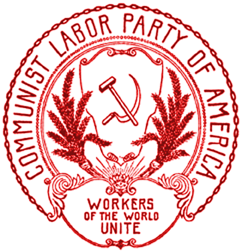
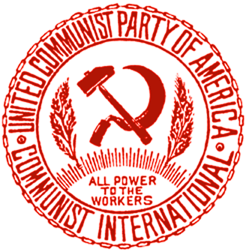
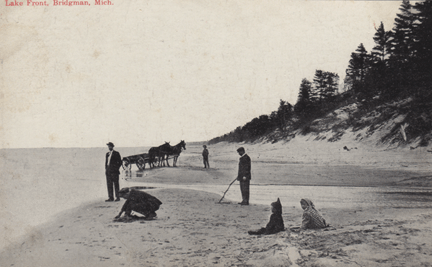
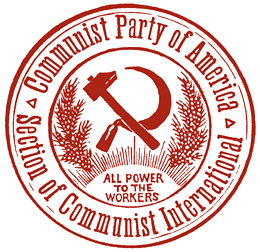
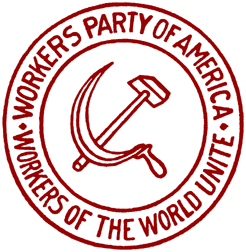
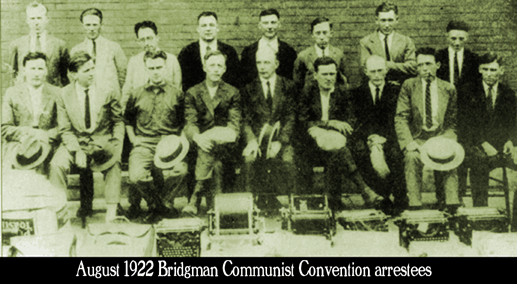
PA25.gif)